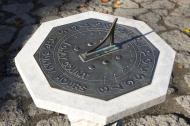Daylight Saving Time – DST
Daylight Saving Time (DST) is the practice of setting the clocks forward one hour from standard time during the summer months, and back again in the fall, in order to make better use of natural daylight.

The sculpture "Six Public Clocks" in London.
Commuters and tourists walking through the sculpture Six Public Clocks by Konstantin Grcic in 1999 in Canary Wharf, London, U.K..
©iStockphoto.com/william87
DST Changes — Dates and Local Times
Clocks Back or Forward?
“Spring forward, fall back” is one of the little sayings to help remember which way to set your watch. You set your clock forward in the spring when DST starts (= lose one hour), and back one hour when DST ends in the fall (= regain one hour).
Daylight Savings or Saving?
Northern Hemisphere
USA, Central America, Canada, Europe, Asia, northern Africa
Many countries in the Northern Hemisphere (north of the Equator) use DST in the summer time, but not all. Daylight Saving Time usually starts in March-April and ends in September-November when the countries return to standard time.
Where Will DST Start or End Next?
Southern Hemisphere
Australia, New Zealand, South America, southern Africa
In the Southern Hemisphere (south of the equator) the participating countries usually start the DST-period in September-November and end DST in March-April.
100th Anniversary in April 2016
Even though Germany is commonly known as the first country to implement DST, Thunder Bay in Ontario, Canada implemented DST already in 1908. The first use of modern DST in Germany was on April 30, 1916.
DST Statistics — Past and Present Use
Suggested Earlier
US inventor and politician Benjamin Franklin first proposed the concept of DST in 1784, but modern Daylight Saving Time first saw the light of day in 1895. At that time, George Vernon Hudson, an entomologist from New Zealand, presented a proposal for a two-hour daylight saving shift.
Why Use DST at All?
Less than 40% of the countries in the world use DST. Some countries use it to make better use of the natural daylight in the evenings. The difference in light is most noticeable in the areas close to the Poles, i.e. furthest away from the Earth's Equator.
Some studies show that DST could lead to fewer road accidents and injuries by supplying more daylight during the hours more people use the roads. Other studies claim that people's health might suffer due to DST changes.
DST is also used to reduce the amount of energy needed for artificial lighting during the evening hours. However, many studies disagree about DST's energy savings and while some studies show a positive outcome, others do not.
Pros and Cons of DST
Not Always 1 Hour
Today clocks are almost always set one hour back or ahead.
However, on Lord Howe Island, Australia (UTC+10:30), clocks are set only 30 minutes forward from Lord Howe Standard Time (LHST ) to UTC+11 Lord Howe Daylight Time (LHDT) during DST.
30 and 45 Minute Time Zones
Throughout history there have been several variations, like half adjustments (30 minutes) or double adjustment (two hours). Adjustments of 20 and 40 minutes have also been used.
In This Article
- Clocks Back or Forward?
- Northern Hemisphere
- Southern Hemisphere
- 100th Anniversary in April 2016
- Suggested Earlier
- Why Use DST at All?

Daylight Saving Time – DST
- What is DST?
- One Hour Back or Forward?
- What is Standard Time?
- Savings or Saving?
- Pros and Cons of DST
- Your Health and DST
- Summer or Winter Time?
- History of DST
- History of DST in Europe
- DST Statistics
Daylight Saving Time Changes:
Sunrise & Sunset Times







Share this page / Follow us on:
Visit us on: